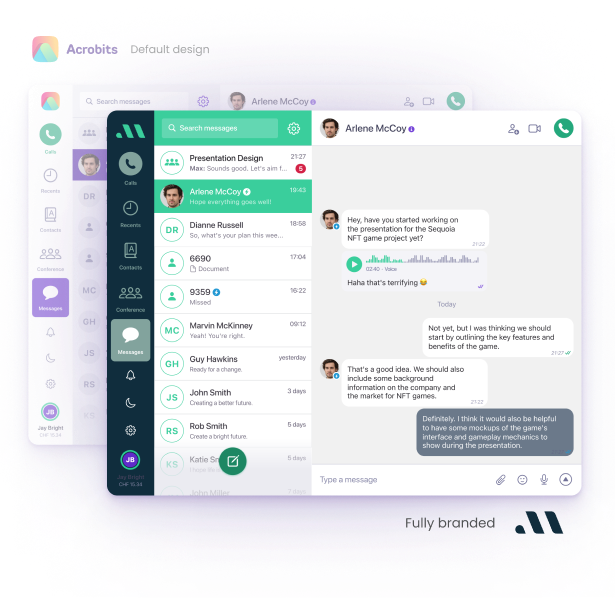
Build a white label softphone app
Create a custom white-label softphone with Cloud Softphone.
- No devs needed
- Native desktop apps
- 100+ premium features

There’s no denying AI is making inroads in almost every part of business. But what happens when it comes to customer service?
AI is transforming how businesses interact with their customers by automating repetitive tasks, analyzing data in real-time, and enabling personalized experiences at scale.
From chatbots that resolve issues instantly to predictive algorithms that anticipate customer needs, AI is redefining how we communicate for the better.
So, I’ve examined how AI is transforming customer communication across industries, from improving customer service and automating workflows to preventing fraud and optimizing real-time interactions. I’ve also taken a closer look at how businesses can structure their information architecture to maximize AI’s effectiveness and scalability.
AI is shaking up customer communication by making interactions faster, smarter, and far more personalized.
Instead of customers waiting on hold or getting stuck in endless email chains, AI-powered tools provide instant answers and real-time support.
Businesses are using AI to predict customer needs before they even ask. How? AI-powered chatbots analyze past interactions, recognize patterns, and adapt to different situations rather than simply following a script. This allows AI to offer relevant responses rather than just directing users to FAQ pages.
AI-driven messaging platforms are also improving their ability to understand tone and intent, ensuring interactions feel more human and engaging.
AI will struggle to provide useful answers if a company’s data is unstructured, outdated, or too shallow.
Businesses need to organize their knowledge bases logically, making it easy for AI to retrieve and deliver information in a natural, helpful way.
AI-powered softphone technology is changing the game for voice-based communication by ensuring calls are routed efficiently, conversations are analyzed for insights, and workflows are automated to improve customer interactions.
Across industries, AI enhances customer engagement, improves efficiency, and ensures critical interactions are captured and optimized for better decision-making across industries.
AI-powered call routing eliminates frustrating transfers and long wait times by instantly connecting customers to the right department.
This is especially useful in hospitality, where it directs guests to the appropriate service desk. However, it’s even more advantageous in healthcare as it prioritizes urgent cases to ensure patients receive timely care.
For sales teams, this type of call management streamlines the customer experience by seamlessly routing high-value leads to senior representatives. This ensures maximum efficiency and elevates customer satisfaction levels.
AI-driven virtual assistants streamline routine customer interactions by handling appointment scheduling, booking confirmations, and general inquiries. By automating these tasks, businesses reduce the burden on human agents, allowing them to focus on more complex customer needs.
These intelligent systems also enhance enterprise communication workflows efficiency by integrating with CRM platforms, automatically logging interactions, and prioritizing customer queries.
Additionally, in sectors like secure communications, AI helps manage access controls and automate compliance processes, ensuring organizations meet regulatory requirements while maintaining seamless operations.
By automating these essential workflows, AI enhances customer response times, minimizes manual effort, and improves overall service efficiency, making businesses more agile and responsive to customer needs.
Scam calls have become a major issue for businesses and consumers, and even the FCC is now at risk, with fraudsters using increasingly sophisticated tactics to trick people into revealing sensitive information.
AI plays a critical role in identifying, blocking, and neutralizing scam attempts before they cause harm.
Advanced AI-driven fraud detection systems can analyze voice patterns, call metadata, and conversational cues to detect potential scam calls in real-time.
A recent study published on ResearchGate highlights how AI models detect fraudulent or deceptive phone calls by analyzing speech patterns, behavioral cues, and inconsistencies in real-time conversations.
By identifying signs of deception—such as hesitations, unnatural pauses, or rapid speech variations—AI can flag suspicious calls before they escalate. This capability is particularly valuable for financial institutions, telecom services, governmental, and enterprise security, where scam calls can lead to significant financial and reputational damage.
Some AI models use predictive algorithms to assess risk factors based on known scam behaviors, flagging suspicious calls and warning users before they engage.
Others integrate natural language processing (NLP) and sentiment analysis to detect coercion, urgency tactics, or deceptive speech patterns often used by scammers.
One fascinating example is Daisy, an AI-powered chatbot designed to waste scammers’ time. This AI “granny” engages scammers in long-winded, nonsense conversations, effectively preventing them from reaching real victims.
In this context, AI-driven scam defense is a game-changer for telecom providers and consumer protection agencies.
AI-driven speech analytics captures emotions and conversational patterns in real-time, allowing businesses to fine-tune interactions as they happen.
Instead of relying on post-call surveys, AI-powered speech analytics detects emotions, tone, and speech patterns as conversations happen, allowing companies to respond dynamically and refine service strategies.
In telecom, AI-driven speech analytics identifies recurring issues, detects frustration early, and guides agents in real-time.
If a customer sounds agitated, AI can trigger coaching suggestions or flag the call for escalation, ensuring a smoother resolution.
AI improves agent training and engagement strategies for resellers and enterprise providers by analyzing conversations to highlight successful responses, common objections, and optimized call scripts.
This allows businesses to tailor training programs and ensure teams are better prepared to handle complex customer interactions.
AI-driven transcription and summarization tools, such as Otter.ai, transform how businesses capture and analyze customer interactions.
These tools ensure that post-call insights, action items, and customer concerns are documented for future reference and follow-ups. By integrating with CRM systems and customer support platforms, AI ensures that businesses retain critical information without relying on manual note-taking.
For customer service teams, AI-generated summaries provide accurate records of interactions, helping agents track unresolved issues and improve response times.
In sales, AI captures objections, concerns, and next steps, allowing teams to refine their approach and optimize conversions.
For internal meetings, AI streamlines documentation, ensuring that key decisions and strategies are easily accessible for future reference.
By leveraging AI for meeting and call summaries, businesses improve efficiency, reduce administrative workload, and ensure no critical details are lost. This technology enhances customer communication by maintaining accurate, actionable records that drive better service and stronger relationships.

AI’s impact on customer communication varies across industries, with each sector leveraging AI to address unique challenges.
Below is a breakdown of AI applications across key industries:
| Industry | AI Application |
| Healthcare | AI-powered virtual assistants assist with appointment scheduling, handling patient follow-ups, symptom monitoring, and real-time triage support. |
| Hospitality | AI enhances guest experiences by streamlining booking confirmations, providing multilingual support, and acting as a virtual concierge. Chatbots anticipate customer preferences, helping hotels and travel businesses offer personalized services while reducing response times. |
| Sales & Retail | AI optimizes customer interactions by analyzing past purchases, predicting demand, and offering personalized recommendations. Chatbots facilitate post-sale engagement, ensuring customers receive timely updates on orders, troubleshooting assistance, and tailored promotions that enhance brand loyalty. |
| Secure Communications | AI detects fraudulent calls, prevents scam attempts, improves compliance automation, and verifies caller identities. |
| Telecom & Reselling | AI-powered real-time analytics improve customer service by detecting sentiment and optimizing response strategies. |
In addition to its benefits and multiple use cases, AI in customer communication presents several challenges, particularly around data privacy, structured information, and bias.
AI systems process huge volumes of customer data, raising concerns about how that data is stored, used, and protected. Businesses must ensure AI tools comply with data protection regulations and use encryption methods to safeguard customer information.
For AI to be effective, businesses must create a well-structured knowledge base. Without organized data, AI systems will struggle to deliver relevant responses. To avoid this, businesses must build AI-ready knowledge bases that allow AI to retrieve, process, and deliver meaningful responses.
Since AI learns from historical data, it can inherit biases that affect the accuracy of its responses. To counteract this, businesses should regularly audit AI training models, ensuring they remain fair, inclusive, and aligned with ethical standards.
Although 82% of customers say they will use a chatbot instead of waiting for a representative to take their call, many businesses roll out these bots without building a strong knowledge base.
For AI-powered customer communication to work effectively, businesses must properly structure their information architecture, not just for bots but for every application of the technology.
AI models rely on organized, accessible, and contextual data to provide meaningful responses. If businesses fail to structure their knowledge base correctly, AI assistants and chatbots will struggle to deliver useful answers, often defaulting to generic FAQ links or transferring users to human agents unnecessarily.
As businesses grow, AI systems must adapt to increasing volumes of customer interactions.
Well-organized, flexible architectures allow AI to scale without losing efficiency, ensuring that expanding datasets remain accessible and actionable.
Businesses must follow best practices for structuring their data to ensure AI can retrieve and process information effectively. The following strategies help create an AI-ready information architecture that improves accuracy, efficiency, and scalability.
AI works best when it can easily navigate a structured hierarchy of information.
Websites and internal knowledge bases should be designed with clear, logical folder structures so AI tools can efficiently find, process, and retrieve relevant information.
For example, businesses should create a consistent URL structure that follows a clear path instead of storing customer support articles randomly or embedding answers in hard-to-find locations.
In the first example, an AI model can understand that this URL contains a guide on setting up push notifications for Android because the information is logically categorized. This can be easily added as an on-page element in the form of breadcrumbs. Not only will you ensure accessibility best practices, but also your users will benefit from this.
In the second, AI cannot infer the content from the URL alone, making it harder to retrieve relevant information.
Similarly, internal knowledge bases used for AI training should be structured hierarchically, grouping information by topic, product, and customer concern. By making sure you create logical clusters of information, you’ll pave the way to accessible databases, just make sure your site structure looks less like a cross, and more like it spreads horizontally.
AI models need to access and interpret text-based content to generate meaningful responses.
However, many modern websites rely heavily on JavaScript for content rendering, which can block AI from reading important text.
If AI cannot access content, it cannot provide useful answers.
For example, a company offering technical support via AI should ensure that its troubleshooting guides are formatted in a way that AI can read them. If a chatbot receives a query like “How do I reset my account password?” it should be able to retrieve structured content like this:
If this information were hidden inside JavaScript-dependent content, the AI would be unable to extract the steps and instead direct the customer to an unrelated FAQ.
One of the most common mistakes businesses make when implementing AI chatbots or virtual assistants is relying only on static FAQ documents rather than real customer interactions.
AI must be trained on authentic conversations to understand context, intent, and variation in customer queries.
How to train AI effectively:
For example, a customer might ask: “How do I update my billing information?” A traditional chatbot relying on static FAQs may respond: “Please visit our billing help page.”
However, an AI trained on real customer conversations will recognize different phrasings and follow-ups, allowing it to generate a more useful response: “You can update your billing information by logging into your account and going to ‘Settings’ > ‘Billing.’ Would you like me to walk you through the steps?”
AI-driven customer communication should feel like an extension of the business, not a generic automated response.
To achieve this, businesses must ensure that AI-generated responses reflect the company’s brand voice and tone.
A brand voice guide for AI should include:
For example, an AI used by a financial services company should sound reliable, knowledgeable, and professional. In contrast, an AI for a gaming company’s support team might be more casual and playful.
If a tech support AI is handling a customer issue, it should:

A well-structured information architecture improves current AI performance and ensures scalability. As businesses expand their AI capabilities, they need a structured foundation that allows AI models to process, retrieve, and generate responses quickly and accurately.
For AI-powered customer communication to truly succeed, businesses must invest in structured, AI-friendly knowledge bases.
Organizing information logically, making content AI-readable, training AI on real interactions, and ensuring brand voice consistency are essential for delivering meaningful, scalable AI-driven customer experiences.
While AI is great at handling routine customer interactions, humans still play an essential role in customer communication, and this should not be ignored.
While AI can answer common questions, route calls, and analyze conversations, it can’t replicate human empathy, intuition, or creative problem-solving. That’s why businesses must find the right balance between AI and human support.
Chatbots and virtual assistants should take care of simple inquiries and repetitive tasks, while human agents handle more complex issues that require a personal touch.
Customers appreciate efficiency, but when they have a serious concern or a nuanced question, they want to speak to a real person.
Another key to maintaining a human touch is ensuring that AI interactions feel natural and conversational. Customers don’t want robotic, overly scripted responses. AI tools should be trained to recognize tone, urgency, and context so that responses feel tailored rather than generic.
AI should also know when to step aside and transfer customers to a human agent when necessary.
As workplaces evolve and technology advances, AI-driven customer communication will only get smarter and more intuitive.
The days of stiff, scripted AI responses are fading as AI tools become more conversational, adaptive, and context-aware.
Businesses are moving toward AI that can handle free-flowing, dynamic conversations, responding naturally instead of relying on pre-set scripts.
AI will move beyond simply responding to customer inquiries and start anticipating needs before they arise. By analyzing past interactions and customer behavior, AI can offer solutions before a customer even asks for help. This will create a proactive, rather than reactive, customer service experience, making businesses more responsive and efficient.
Smarter AI training models will also allow businesses to train AI faster and with greater accuracy. AI will become better at handling unstructured data, which means it won’t always need a perfectly formatted knowledge base to provide accurate responses.
AI-human collaboration will also continue to improve, with AI tools acting as intelligent assistants rather than replacements.
Overall, businesses that embrace AI in a considered, strategic way will see faster response times, more personalized interactions, and higher customer satisfaction.
With 87% of global organizations recognizing the competitive edge AI offers, it’s clear this technology is more than just a trend. It’s already having a long-term effect on reshaping customer communication, making interactions faster, smarter, and more secure.
From fraud prevention and speech analytics to workflow automation and real-time customer insights, AI is transforming how businesses engage with their audiences.
Companies that implement AI with structured knowledge, ethical considerations, and scalable information architecture will gain a competitive edge—enhancing customer relationships while ensuring AI supports, rather than replaces, the human touch.
string(9) "book-demo" string(33) "Build a white label softphone app"
Create a custom white-label softphone with Cloud Softphone.

2024 was a big year for the telecom sector. This year’s shaping up to be even bigger. From artificial intelligence and regulatory challenges to Wi-Fi 7 and 6G, here are seven ways we expect the telecom industry to evolve in 2025. 1. AI Shapes Both Present and Future Unsurprisingly, artificial intelligence remains both the most […]

Within an organization, teams and departments typically develop their own bonds and their own ways of communicating. But what happens when people from various business functions are brought together for a specific project? There are many advantages to cross-functional teams, which combine skills and resources to move projects forward and solve problems creatively. But the […]

TLDR: As MaX UC reaches it’s end-of-life, providers must decide between brand control, simplicity, or cost savings. Options include: Microsoft Teams for stability Cloud Softphone for flexibility and independence Or a reseller path for low-cost operations Each path comes with unique trade-offs in branding, customization, and long-term growth potential. Choose based on your priorities: fast […]

At Acrobits, we’ve never been good at standing still. Ever since we developed the first mobile VoIP application to appear on iTunes and Google Play, we’ve been looking for new ways to enhance our customer offerings. Always with One Goal in Mind Creating new opportunities to make our applications more compelling and the user experience […]